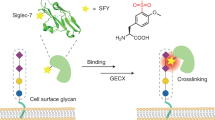Abstract
Glycobiology, in particular the study of carbohydrate–protein interactions and the events that follow, has become an important research focus in recent decades. To study these interactions, many assays require homogeneous glycoconjugates in suitable amounts. Their synthesis is one of the methodological challenges of glycobiology. Here, we describe a versatile, three-stage protocol for the formation of glycoconjugates from unprotected carbohydrates, including those purified from natural sources, as exemplified here by rhizobial Nod factors and exopolysaccharide fragments. The first stage is to add an oligo(ethylene glycol) linker (OEG-linker) that has a terminal triphenylmethanethiol group to the reducing end of the oligosaccharide by oxime formation catalyzed by aniline. The triphenylmethyl (trityl) tag is then removed from the linker to expose a thiol (stage 2) to allow a conjugation reaction at the thiol group (stage 3). There are many possible conjugation reactions, depending on the desired application. Examples shown in this protocol are as follows: (i) coupling of the oligosaccharide to a support for surface plasmon resonance (SPR) studies, (ii) fluorescence labeling for microscale thermophoresis (MST) or bioimaging, and (iii) biotinylation for biolayer interferometry (BLI) studies. This protocol starts from unprotected carbohydrates and provides glycoconjugates in milligram amounts in just 2 d.
This is a preview of subscription content, access via your institution
Access options
Access Nature and 54 other Nature Portfolio journals
Get Nature+, our best-value online-access subscription
$29.99 / 30 days
cancel any time
Subscribe to this journal
Receive 12 print issues and online access
$259.00 per year
only $21.58 per issue
Buy this article
- Purchase on Springer Link
- Instant access to full article PDF
Prices may be subject to local taxes which are calculated during checkout







Similar content being viewed by others
References
Larsen, K., Thygesen, M.B., Guillaumie, F., Willats, W.G.T. & Jensen, K.J. Solid-phase chemical tools for glycobiology. Carbohydr. Res. 341, 1209–1234 (2006).
Oldroyd, G.E.D. Speak, friend, and enter: signalling systems that promote beneficial symbiotic associations in plants. Nat. Rev. Microbiol. 11, 252–263 (2013).
Broghammer, A. et al. Legume receptors perceive the rhizobial lipochitin oligosaccharide signal molecules by direct binding. Proc. Natl. Acad. Sci. USA 109, 13859–13864 (2012).
Kelly, S.J. et al. Conditional requirement for exopolysaccharide in the mesorhizobium–lotussymbiosis. Mol. Plant-Microbe Interact. 26, 319–329 (2013).
Thygesen, M.B., Sauer, J. & Jensen, K.J. Chemoselective capture of glycans for analysis on gold nanoparticles: carbohydrate oxime tautomers provide functional recognition by proteins. Chem. Eur. J. 15, 1649–1660 (2009).
Thygesen, M.B. et al. Nucleophilic catalysis of carbohydrate oxime formation by anilines. J. Org. Chem. 75, 1752–1755 (2010).
Kawaharada, Y. et al. Receptor-mediated exopolysaccharide perception controls bacterial infection. Nature 523, 308–312 (2015).
Abdiche, Y., Malashock, D., Pinkerton, A. & Pons, J. Determining kinetics and affinities of protein interactions using a parallel real-time label-free biosensor, the Octet. Anal. Biochem. 377, 209–217 (2008).
Bek, A. et al. Improved characterization of nod factors and genetically based variation in lysM receptor domains identify amino acids expendable for Nod factor recognition in Lotus spp. Mol. Plant-Microbe Interact. 23, 58–66 (2010).
Maolanon, N.N. et al. Lipochitin oligosaccharides immobilized through oximes in glycan microarrays bind LysM proteins. ChemBioChem 15, 425–434 (2014).
Villadsen, K., Martos-Maldonado, M.C., Jensen, K.J. & Thygesen, M.B. Chemoselective reactions for the synthesis of glycoconjugates from unprotected carbohydrates. ChemBioChem 18, 574–612 (2017).
Tanaka, T., Nagai, H., Noguchi, M., Kobayashi, A. & Shoda, S. One-step conversion of unprotected sugars to beta-glycosyl azides using 2-chloroimidazolinium salt in aqueous solution. Chem. Commun. 45, 3378–3379 (2009).
Lim, D., Brimble, M.A., Kowalczyk, R., Watson, A.J. & Fairbanks, A.J. Protecting-group-free one-pot synthesis of glycoconjugates directly from reducing sugars. Angew. Chem. Int. Ed. Engl. 53, 11907–11911 (2014).
Sauer, J., Hachem, M.A., Svensson, B., Jensen, K.J. & Thygesen, M.B. Kinetic analysis of inhibition of glucoamylase and active site mutants via chemoselective oxime immobilization of acarbose on SPR chip surfaces. Carbohydr. Res. 375, 21–28 (2013).
GE Healthcare. Thiol Coupling Kit. Instruction 22-0618-10 AB, 1–9 (2003) https://www.gelifesciences.com/gehcls_images/GELS/Related%20Content/Files/1384878377977/litdoc22061810_20161015124116.pdf.
Molecular Probes Inc. Thiol-Reactive Probes. 1–4 (2006) https://tools.thermofisher.com/content/sfs/manuals/mp00003.pdf.
Thermo Scientific. Pierce Biotin Quantitation Kit. 1–5 (2014) https://tools.thermofisher.com/content/sfs/manuals/MAN0011484_Pierce_Biotin_Quantitation_UG.pdf.
Pall FortéBio. Octet® RED96 System http://www.fortebio.com/documents/Octet_RED96_datasheet_1216.pdf.
Xia, B.Y. et al.Versatile fluorescent derivatization of glycans for glycomic analysis Nat. Methods 2, 845–850 (2005).
Price, N.P.J. et al. Functionalized C-glycoside ketohydrazones: carbohydrate derivatives that retain the ring integrity of the terminal reducing sugar. Anal. Chem. 82, 2893–2899 (2010).
Acknowledgements
Generous support by the Danish National Research Foundation (grant no. DNRF79) and by the Villum Foundation (grant no. VKR022710) is gratefully acknowledged. The authors thank C.W. Ronson and J.T. Sullivan for bacterial production of the EPS octa-saccharide and M. loti R7A Nod factors.
Author information
Authors and Affiliations
Contributions
M.B.T., J. Sauer and K.J.J. designed the study. C.T.H., N.N.M., J. Sauer and M.B.T. performed the experiments. C.T.H., N.N.M., J. Stougaard, M.B.T. and K.J.J. wrote the manuscript.
Corresponding authors
Ethics declarations
Competing interests
The authors declare no competing financial interests.
Integrated supplementary information
Supplementary information
Combo pdf
Supplementary Figures 1–3, Supplementary Methods and Supplementary Data 1–3. (PDF 449 kb)
Rights and permissions
About this article
Cite this article
Hjuler, C., Maolanon, N., Sauer, J. et al. Preparation of glycoconjugates from unprotected carbohydrates for protein-binding studies. Nat Protoc 12, 2411–2422 (2017). https://doi.org/10.1038/nprot.2017.109
Published:
Issue Date:
DOI: https://doi.org/10.1038/nprot.2017.109
This article is cited by
-
Current and future advances in fluorescence-based visualization of plant cell wall components and cell wall biosynthetic machineries
Biotechnology for Biofuels (2021)
-
A combination of chitooligosaccharide and lipochitooligosaccharide recognition promotes arbuscular mycorrhizal associations in Medicago truncatula
Nature Communications (2019)
Comments
By submitting a comment you agree to abide by our Terms and Community Guidelines. If you find something abusive or that does not comply with our terms or guidelines please flag it as inappropriate.



